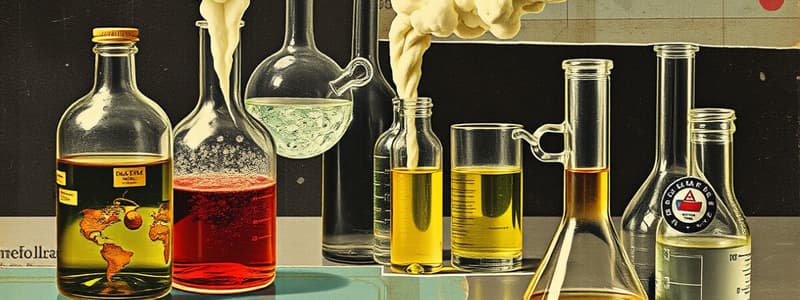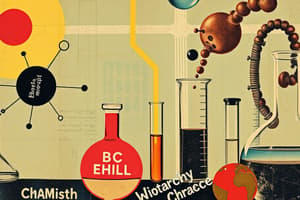Podcast
Questions and Answers
In a chemical reaction, reactants undergo a change to become ____________.
In a chemical reaction, reactants undergo a change to become ____________.
Products
What must undergo a chemical reaction to become a product?
What must undergo a chemical reaction to become a product?
Reactants
A representation of a reaction in formulas is called a ____________.
A representation of a reaction in formulas is called a ____________.
chemical equation
In the law of conservation of mass, the mass of the ____________ must equal the mass of the ____________ in a reaction.
In the law of conservation of mass, the mass of the ____________ must equal the mass of the ____________ in a reaction.
What type of reaction only produces one product?
What type of reaction only produces one product?
What type of reaction has only one reactant?
What type of reaction has only one reactant?
What type of reaction has a single element reacting with a compound and replacing an element in that compound?
What type of reaction has a single element reacting with a compound and replacing an element in that compound?
What type of reaction produces heat and light and frequently produces CO2 and H2O?
What type of reaction produces heat and light and frequently produces CO2 and H2O?
What type of reaction involves two compounds (usually dissolved in water) which switch their ion pairs?
What type of reaction involves two compounds (usually dissolved in water) which switch their ion pairs?
Calculate the number of atoms in 4.25 moles of Na.
Calculate the number of atoms in 4.25 moles of Na.
How many particles are in a mole?
How many particles are in a mole?
Flashcards are hidden until you start studying
Study Notes
Chemical Reactions Overview
- Reactants transform into products during a chemical reaction.
- The process requires reactants to undergo chemical changes.
Chemical Equation
- A chemical equation represents a reaction using formulas to convey the relationship between reactants and products.
Law of Conservation of Mass
- This law states that the mass of reactants must equal the mass of products in a chemical reaction, ensuring no mass is lost or gained.
Types of Reactions
- Synthesis Reaction: Only one product is formed from multiple reactants.
- Decomposition Reaction: Begins with one reactant that breaks down into two or more products.
- Single Replacement Reaction: Involves one element replacing another in a compound.
- Combustion Reaction: Produces heat, light, carbon dioxide (CO2), and water (H2O).
- Double Replacement Reaction: Two compounds exchange ions, typically in aqueous solutions.
Moles and Particles
- One mole of any substance contains approximately 6.02 x 10^23 particles.
- To find the number of atoms in 4.25 moles of sodium (Na), multiply the number of moles by Avogadro's number: 4.25 x 6.02 x 10^23.
Studying That Suits You
Use AI to generate personalized quizzes and flashcards to suit your learning preferences.




